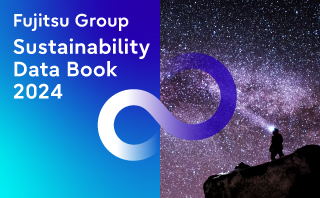-
Sustainability at Fujitsu Group
- Sustainability Management in the Fujitsu Group
- GRB(Global Responsible Business)Goals for FY2025
- GRB(Global Responsible Business)Goals and Achievments for FY2022
- Fujitsu's accessibility
- Stakeholder Engagement
- United Nations Global Compact
- SDG-related Activities in Fujitsu
- External Recognition and Awards
-
Global Responsible Business
- Environment
-
- Environmental Management
- The Fujitsu Group Environmental Vision on Climate Change
- Living in Harmony with Nature (Conservation of Biodiversity)
- Environmental Action Plan
- Environmental Data
- Environmental Communication
- Environmental Social Activities
- Disposal and Recycling of ICT products
- Environmental Considerations in ICT Products
- Governance
-
Data and Documents
- Fujitsu Group Sustainability Data Book 2024
- Social, Governance and Environmental data
- Independent Assurance Report

- GRI Standards / United Nations Global Compact (UNGC) principles Comparison Table
- SASB Standards Comparison Table
- Sustainability Information Disclosure Framework
- Link to regions responsible business reports
- Contact
- Sitemap
Social Well-being
Work Environment
Promoting New Ways of Working with ‘Work Life Shift’ Under the New Normal
Fujitsu is promoting Work Life Shift in these uncertain times to generate higher employee productivity than ever before, while ensuring that creativity and innovation continue to grow.
Work Life Shift is a concept that achieves employee Well-being by focusing not only on ‘work’, but by completely shifting the ‘job’ and the ‘lifestyle’.
We are implementing various initiatives, both in terms of personnel systems and workplace environment changes, that will allow us to create and deliver value for our customers regardless of location or time and that will enable the ongoing transformation of Fujitsu itself.
The Work Life Shift offering consists of three key categories: Smart Working, Borderless Office, and Culture Change.
Smart Working
Approximately 80,000 employees of Fujitsu Group companies in Japan work principally on a teleworking basis (excluding those in manufacturing facilities and those assigned to customer sites). Our employees enjoy an optimal work style that allows them to choose flexible working hours and a work location that suit the characteristics and objectives of their work tasks as well as their lifestyle.
Borderless Office
Freed from the constraints of working in a traditional fixed workplace, employees can select a location that ideally matches the required task – be it their home, a hub office, a satellite office, or other appropriate workspace.
Culture Change
People management founded on high levels of employee autonomy and trust will generate maximized team performance and enhanced productivity.
Announcing Work Life Shift 2.0 -- DX Company Work Styles that Cater to Everyone’s Well-being
In October 2021, Fujitsu announced Work Life Shift 2.0 as a way to achieve a true hybrid work style that includes the effective use of real communication in the office and also aims to provide workers a more fulfilled life. The new version puts in place more advanced measures that reflect both employee feedback and issues that arose when the original Work Life Shift was implemented.
- Practical Hybrid Work and the Evolution to “Experience Place”
As we look towards a post-COVID future, the office is evolving from the workplace of the past to an “experience place” that offers experiences only available at the office. New ways of using the office provide greater collaboration through real communication as we transition to a true hybrid work style that combines the real with the virtual. - Evolution of Work Styles for a DX Corporation
At Fujitsu, we are making the value of the various experiences gained from putting hybrid work into practice visible as data as we move towards a work style that boosts productivity while allowing for greater creativity. We are also further stepping up our collaborations with other corporations and local governments who support the Work Life Shift concept and contributing to the resolution of problems for our customers and the community more broadly. - Enabling Work-Life Synergies
By leveraging flexible work styles to make workers’ home lives more fulfilling, we are generating synergies and promoting new value creation, as well as achieving greater engagement and improving the well-being of all our employees.
Fujitsu Telework System
In April 2017, Fujitsu formally introduced a telework system that allows for flexible ways of working that are not tied to a specific location. This system is available to all 35,000 Fujitsu parent company employees in Japan and includes working from home or a satellite office as well as working during business trips.
The telework system facilitates business continuity in emergency situations such as the spread of infectious diseases and during natural disasters, providing for work innovations such as holding online meetings and digitizing written materials. It also provides an environment that makes it easier for employees with other commitments, such as raising children or caring for relatives, to continue working, helping Fujitsu to support and retain valuable personnel.
Goals of the System
- To boost individual productivity and maximize the benefits of team work
- To build an environment that supports continued participation by a diverse range of staff
- To ensure business continuity and rapid responses to disasters
Initiatives Aimed at Reducing Long Working Hours
The Fujitsu Group aims to improve the well-being and productivity of every employee through a variety of initiatives aimed at reducing long working hours. By promoting Work Life Shift, we aim to implement practical hybrid work modes that combine real and virtual work to suit job goals, thereby improving productivity and creativity in work styles that create new value.
Examples of specific initiatives aimed at reducing long working hours:
- Creating mechanisms to balance the workload across each day (canceling core time in flex time systems and utilizing breaks and restarts)
- Promoting refresher periods (setting a recommended number of annual leave days to suit the summer and New Year breaks)
- Using push notifications relating to working hours (sending alert e-mails regarding overtime work, displaying pop-up messages in punch in/out systems regarding health and communications for people working long hours)
- Improving management (management education on working hours)
Support for a Healthy Work-Life Balance
Fujitsu and its domestic Group companies aim to generate new forms of value through Work-Life Synergies. We support each employee’s efforts to enrich their career with initiatives in areas such as childcare and nursing care.
- Childcare
- Childcare leave (available until the day prior to the child’s 1st birthday, but extendable until the first April 20th following the child’s 2nd birthday depending on the availability of day care)
- Childbirth support leave (up to 20 days (4 weeks) can be taken by spouses or partners up to 8 weeks before or after the birth of the child)
- Use of annual leave is permitted during childcare leave (up to 20 days (4 weeks) can be taken)
- Child illness/injury leave (to provide nursing care, accompany the child for vaccinations or health checks, take part in school events, etc.)
- Childcare reduced working hours system (up to March 31 in Year 6 of elementary school; can reduce by a maximum of 2 hours per day)
- Establishment of corporate childcare centers
- Subsidies for babysitting service expenses
- Remote working (support for raising a disabled child, single parents, or families where a spouse is posted overseas)
- Cafeteria Plan (can be used to purchase childcare products such as diapers and breast pumps, or for kindergarten or after-school care fees)
- Nursing care
- Leave for nursing care and preparing for nursing care (up to 1 year in total per family)
- Family care leave (up to 20 days (4 weeks) available)
- Care giving reduced working hours system (until the issue requiring care is resolved)
- Remote work (family care giving/nursing)
- Release of a care giving handbook
- Establishment of a contact point for advice
VOICE Program
The Fujitsu Group launched the VOICE Program in October 2020, as a project to "not only listen indirectly to customers' ‘voices’, but also listen more directly and more often" as well as to "directly link the opinions of the Fujitsu Group’s 130,000 employees to management". The concept of VOICE is symbolized by the slogan "change one's voice into a force and create a wind of change". This is an activity that aims to heighten corporate competitiveness by collecting the ‘voices’ of customers and employees and – by using them to speed up decision-making in business activities – thereby change behavior, raise awareness, and generate encounters.
As part of efforts to enhance the workplace environment, we periodically conduct surveys related to Work Life Shift and the results are reflected in a range of measures that leverage the VOICE program, such as business process reforms and the review of systems and operations. This leads to improvements in employee experience and employee engagement.
Measures to Enhance Communication
Labor Relations
Fujitsu has a union shop agreement with the Fujitsu Labor Union. Based on this, we hold discussions on various conditions of employment conditions and explain management policies and business conditions, along with business reorganization and other matters, to employees through regular and ad hoc meetings such as the Labor Council or Productivity Council. These agreements also stipulate the collective bargaining rights of the union.
In Europe, the Fujitsu European Labor Relations Council Annual General Meeting has taken place every year since 2000, with the overall financial conditions of the Fujitsu Group and other issues shared with employee representatives from Fujitsu Group companies.
Fujitsu has established a consultation service as a contact point for queries to the Human Resources and Administration Units. This is part of a structure that is designed to make it easy for employees to seek guidance on human resource and administrative programs.
In-house Social Media Network
The Fujitsu Group uses an in-house social media network to strengthen the ties between people all around the world, enabling diverse and talented employees to engage in communication that goes beyond the organization. As communities become more diverse, this network offers spontaneous forms of communication for employees that extends beyond mere interchanges within the organization, encouraging new business plans, secondary jobs and workations, and allowing exchanges of information on careers in the life sphere, such as child-raising and caring.
It is also used by employees to discuss opinions and aspirations circulating in the community, such as staff management policies and the environment.
Initiative to Boost Psychological Safety
Fujitsu Design Initiative for Psychological Safety -- A Project to Design Psychological Safety
In June 2021, the Fujitsu Group initiated a project to design psychological safety into its organizational environment such that the environment will promote mutual trust among its employees as they tackle challenges and experience failures.
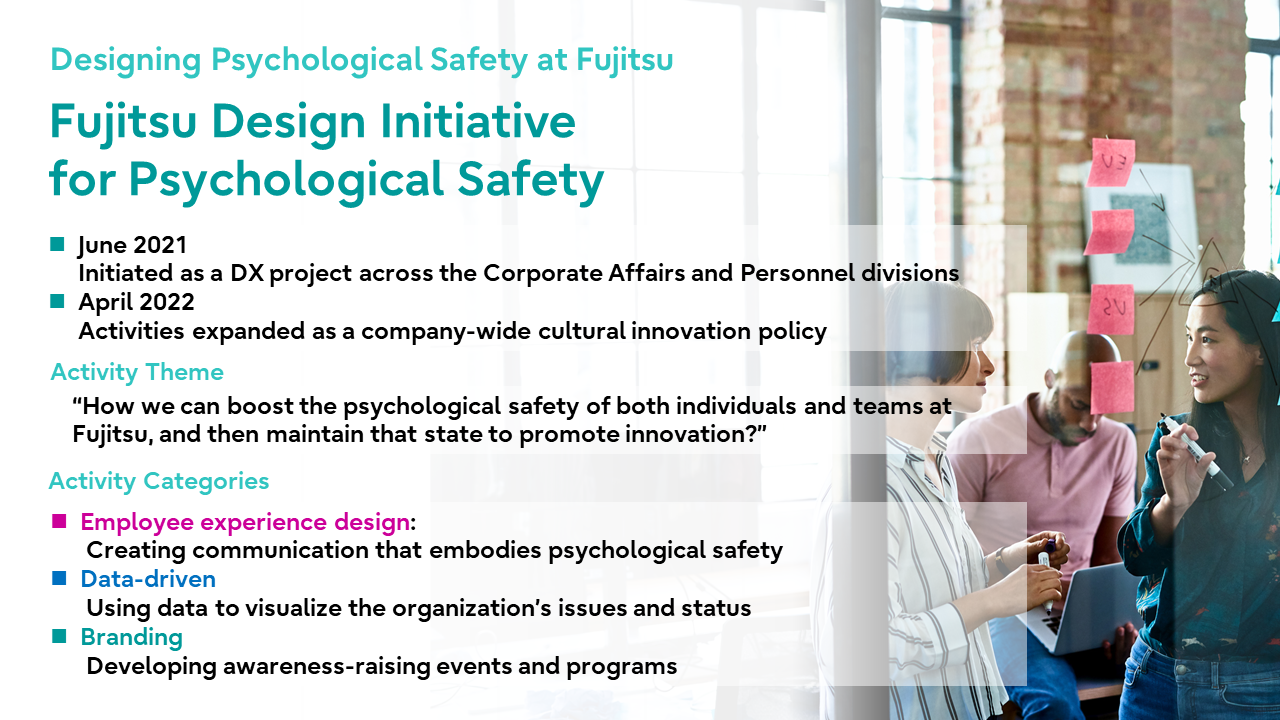 Overview of the Fujitsu Design Initiative for Psychological Safety
Overview of the Fujitsu Design Initiative for Psychological Safety
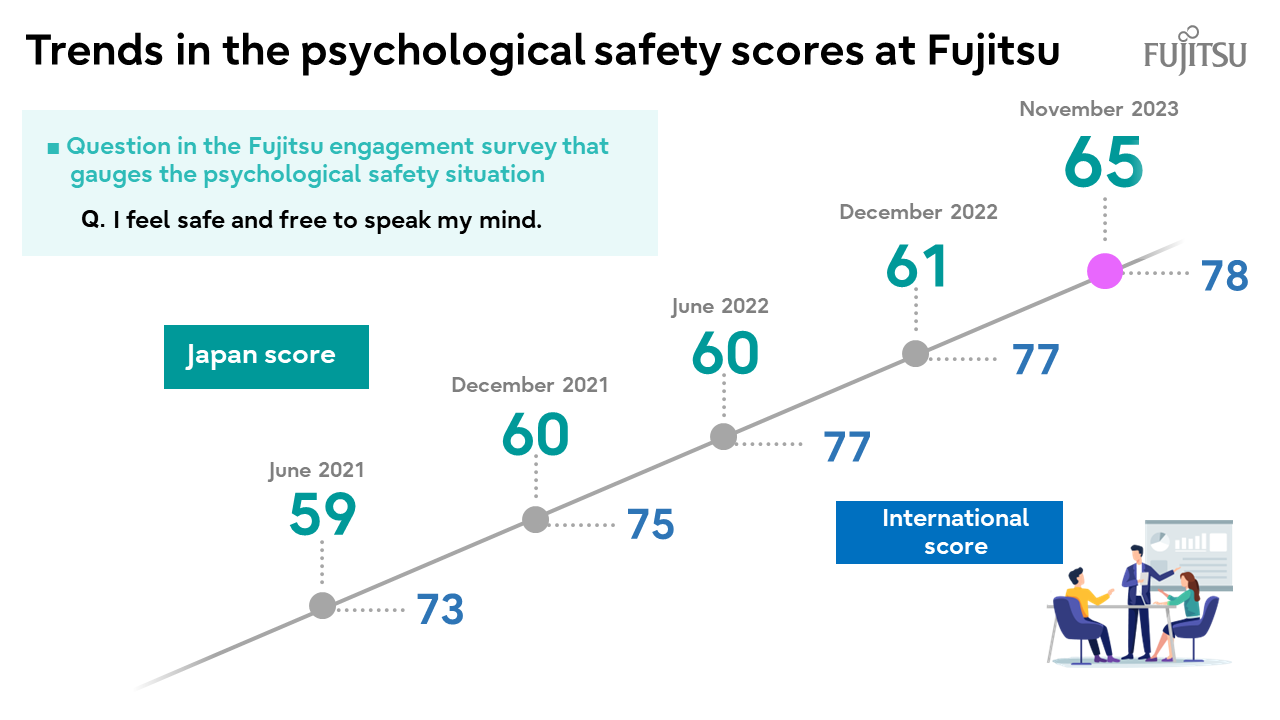 Trends in the psychological safety scores at Fujitsu
Trends in the psychological safety scores at Fujitsu
Global surveys are conducted twice a year to monitor employee engagement so that we are kept in touch with our organizational culture and are quickly made aware of changes in employees’ work styles, opinions and attitudes. That way, we can apply the survey outcomes to our management practices in a timely way. The scores for psychological safety in these surveys improved by 6 points in Japan and by 5 points internationally between June 2021 and November 2023.
- Promoting the project through design concepts
This project poses the question of how we can boost the psychological safety of both individuals and teams and then maintain that state to promote innovation. It also puts forward the overall project design and the communication solutions as design concepts. Promoting the project through design concepts leverages the diversity of the design team members so that problems can be solved creatively from the perspective of employees. - Regular online events
In the roughly 3 years since 2021, we have held 7 online psychological safety events, with more than 2,700 employees taking part. Senior executives and Directors have taken to the stage at these events with the aim of inspiring confidence that we take psychological safety seriously at the highest levels and are actively engaged. Through these events, we have received feedback on psychological safety from more than 600 participants, and we are using this information for qualitative analysis. - Formulation of a unique model for improving psychological safety
Based on a range of survey data, including engagement surveys, and other employee feedback, Fujitsu has formulated its own original psychological safety improvement model and activity guidelines. - Release of the free “Fujitsu Psychological Safety Playbook”
To promote better understanding and behavioral change among employees around psychological safety, we released a “Playbook” within the company to provide a basic understanding and improvement models. The Playbook has now been viewed over 7,000 times in all. In May 2024, we updated the content of the Playbook released internally with the aim of providing practical tips for everyone who works in corporate bodies that are engaged in human capital management and cultural innovation.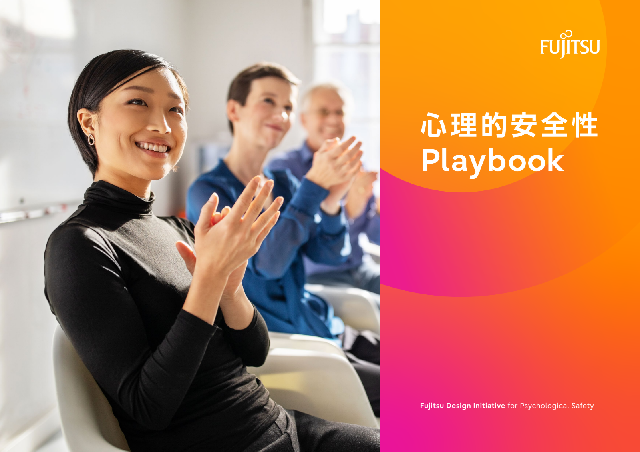 Fujitsu Psychological Safety Playbook
Fujitsu Psychological Safety Playbook- Fujitsu Psychological Safety Playbook Download
*Japanese Only
- Fujitsu Psychological Safety Playbook Download
- Development and delivery of Psychological Safety Improvement Programs
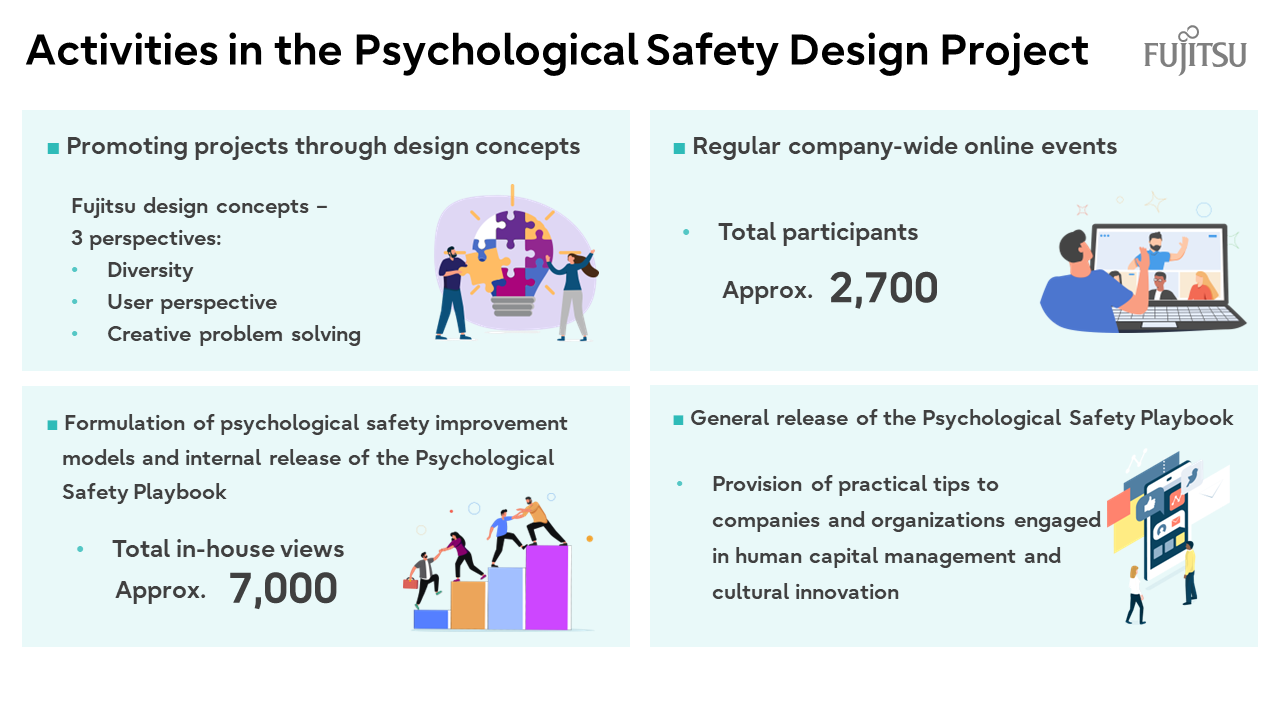 Activities in the Psychological Safety Design Project
Activities in the Psychological Safety Design ProjectPsychological Safety Improvement Programs have been developed for each part of the organization and have been delivered to 2,230 people so far. In organizations where these programs have been delivered, psychological safety scores on engagement surveys have improved and substantial changes in behavior are being seen that will lead to greater psychological safety.
Key Initiatives in Regions Outside Japan
WeCare Program in the Asia Pacific Region
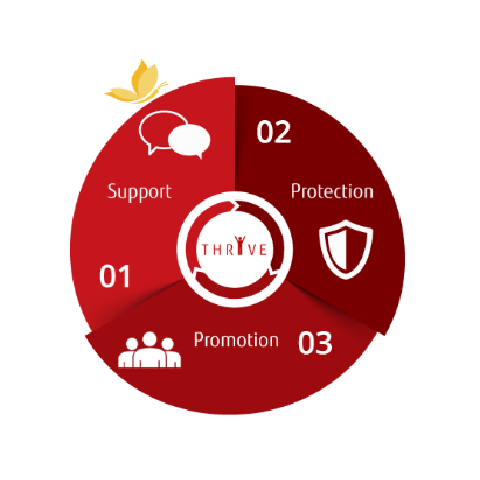
In the Asia Pacific region, we are rolling out our WeCare mental healthcare program for all our employees. The WeCare app provides help sheets, guidebooks, posters and a mood meter to ensure that everyone at Fujitsu has the tools they need to spot the signs that someone around them needs support, and tells them what action to take.
Beach Cleanup in East Asia
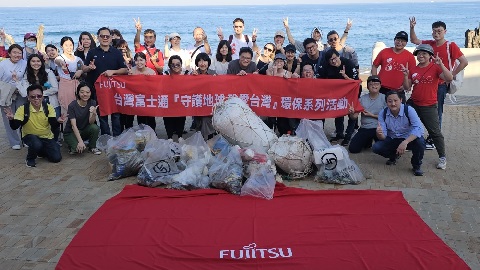
To celebrate the 28th anniversary of Fujitsu Taiwan's founding and to promote a sustainable business philosophy, a beach cleanup activity was held in Taiwan on November 3, 2023. Around 40 employees took part, collecting 50 kilograms of trash in two hours.
World Kindness Week in the Global Delivery Center (GDC)
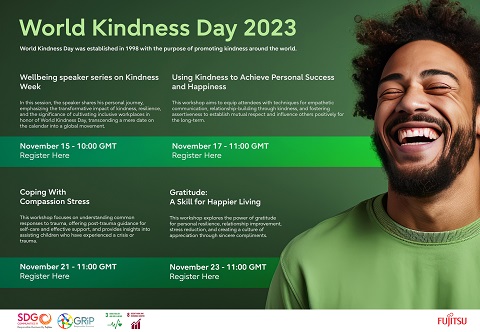
We held 4 sessions at the Global Delivery Center (GDC) to coincide with World Kindness Week. More than 700 employees took part in sessions on themes such as: Journey of being Kind during Life Challenges, Using Kindness to Achieve Personal Success and Happiness, Coping with Compassion Stress; and Gratitude: A Skill for Happier Living. Participants shared what they can do individually to create a better workplace in the session.
FY2023 Performance
Initiatives Aimed at Reducing Long Working Hours
The discretionary working system applies to 18% of employees, and the flex time system applies to 77% of employees (Fujitsu Limited)
Telework Rate
The telework rate is around 75%.
Unionization Rate
The unionization rate is 74.4% (Fujitsu Limited) *Calculation basis includes managers and non-regular employees who are not union members.
Turnover Rate
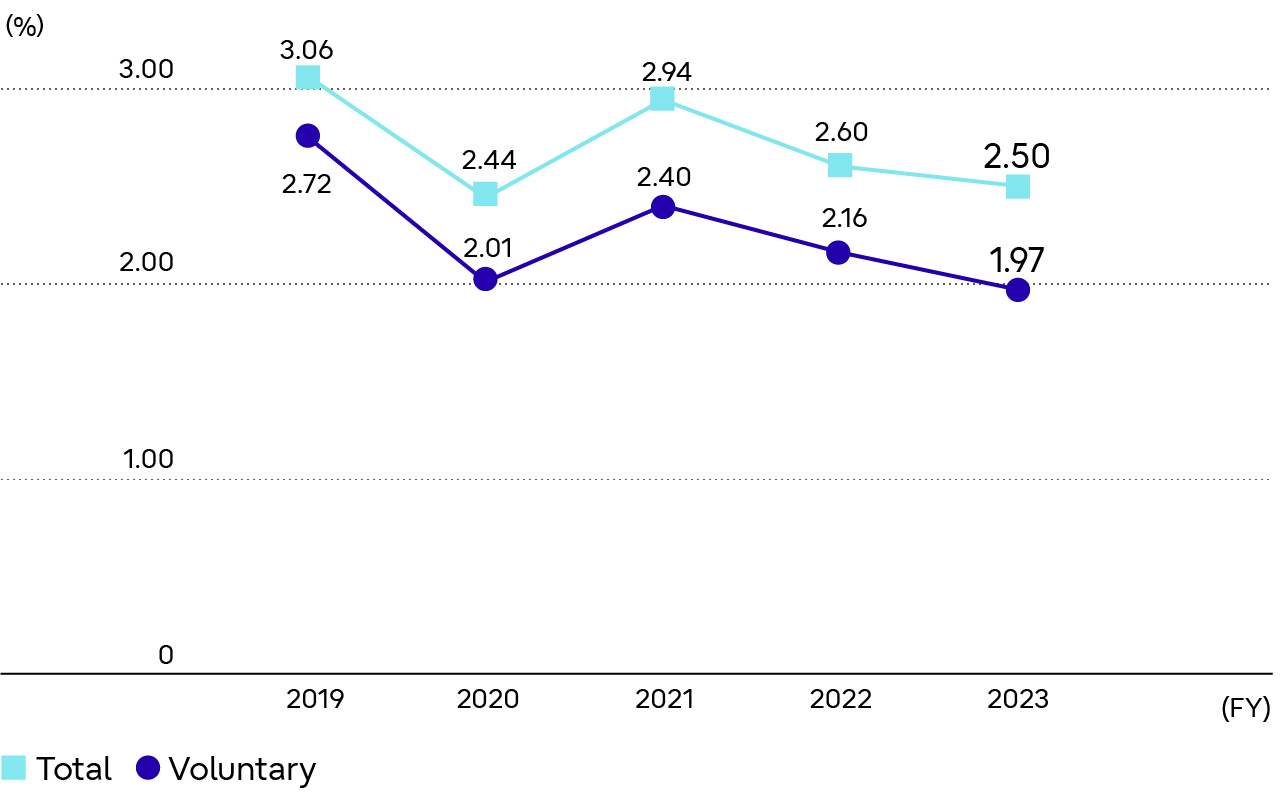 Turnover Rate (Fujitsu)
Turnover Rate (Fujitsu)


